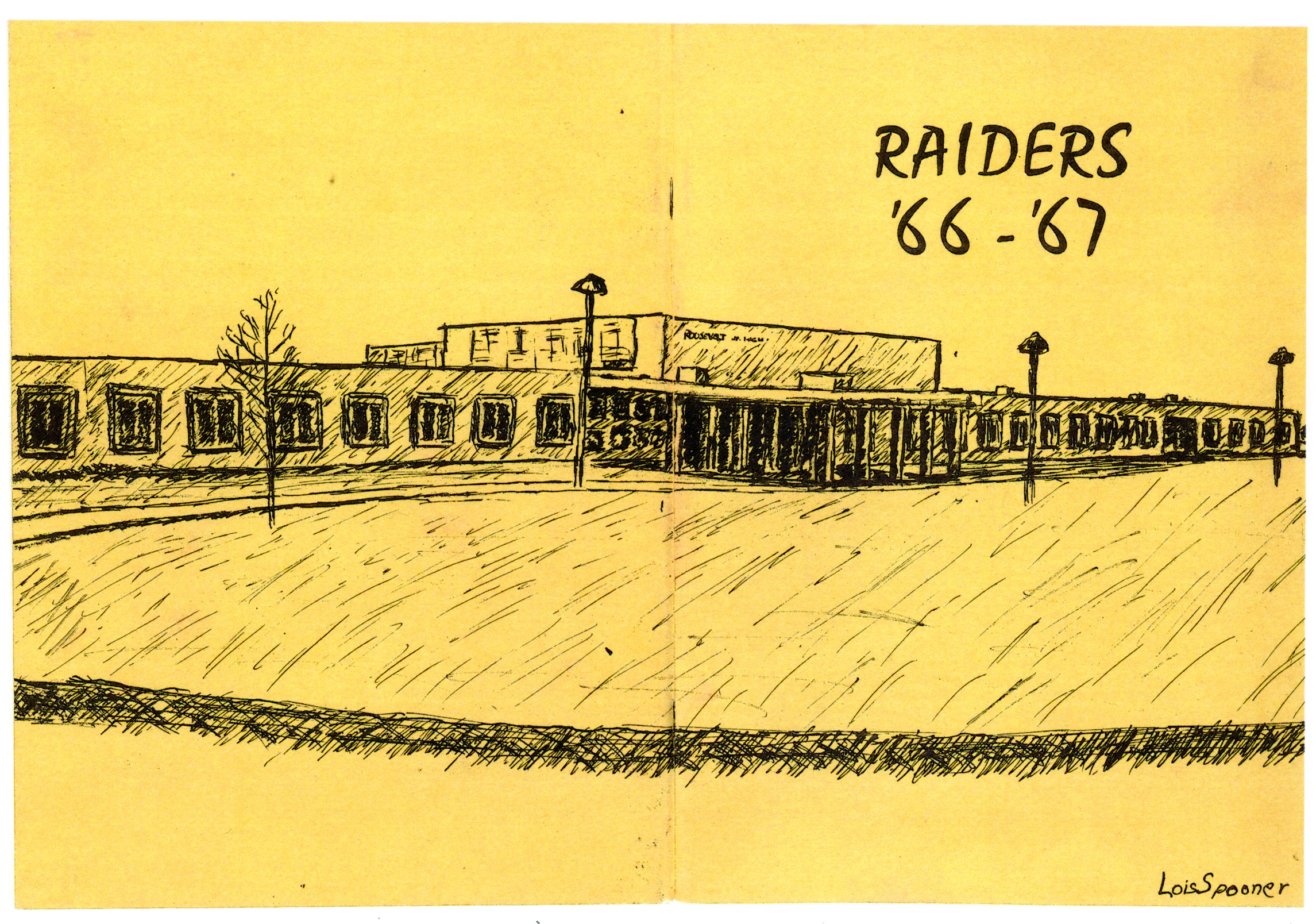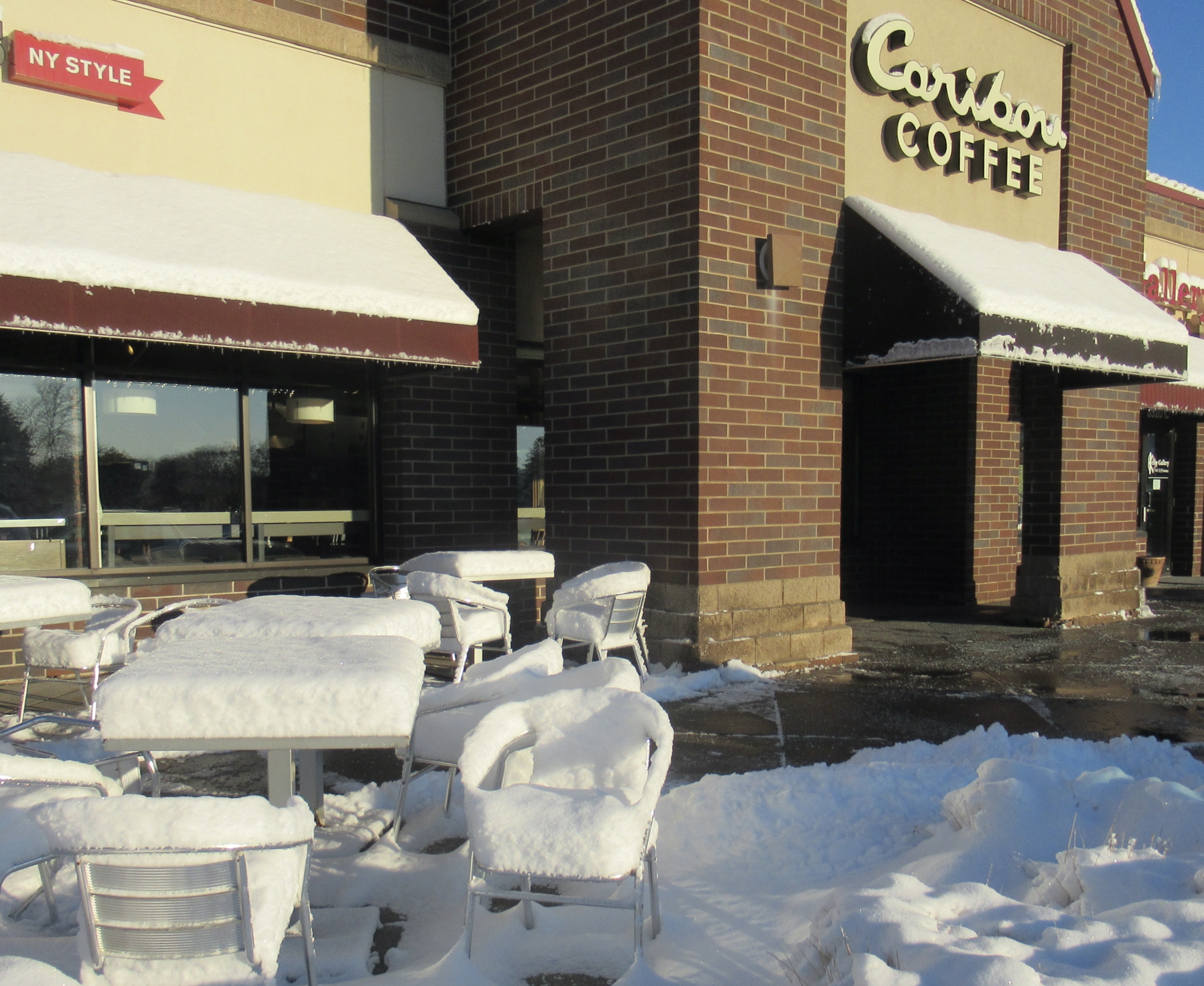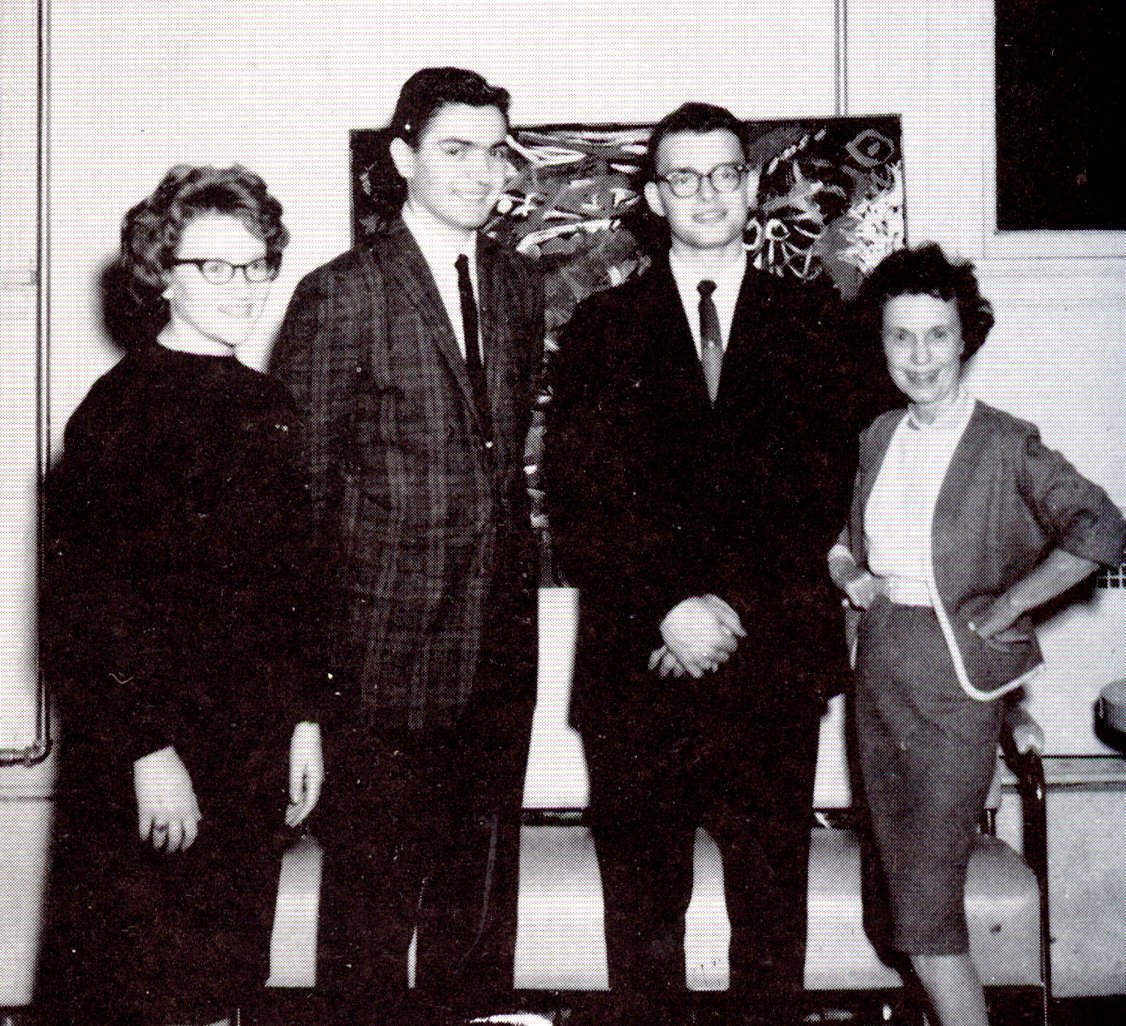Like many in my age cohort, life becomes a daily exercise in divestment: Who would want this? Why am I keeping that?
In a cabinet in the garage, was the 1966-67 yearbook of the 1300 student Roosevelt Junior High School in Blaine MN. I was in my fourth year of teaching, second year there. The yearbook surfaced in a box – I hadn’t looked at it for many years. Now, 57 years later, I took the time, and glad I did. I bet you can identify…. At minimum, we’ve all been a newby teenager once.
57 years is not quite like yesterday, but it was fascinating to browse the 46 or so pages, which brought back lots of memories from that time in my life. (Included below is a portion of the Annual, including three sample pages of some real, genuine, 7th, 8th and 9th graders who filled the halls and desks at Roosevelt that year: (here: Roosevelt 1966 67). No surprise, those kids look pretty much like kids the same age today, except they’re now in their 70s!)
Here’s the cover of the “Raiders’ annual. Note especially the name of the artist, Lois Spooner.

This post isn’t about my own memories of 1966-67, or any other year for that matter, but I’d encourage your personal nostalgia trip, from being a teen, and later, about whatever else comes to mind. Life is full of events. Sometimes, pictures are worth a thousand words!
Junior High (generally grades 7-9) or Middle School (grades 6-8), bring together youngsters between about 12-15. We have or had kids and kin and neighbors navigating those sometimes difficult waters.
Early on in the 1966-67 annual, between the photos of Principal and Assistant Principal, was a succinct statement of philosophy to the reader, most likely a parent of a child in the book: “A junior high school is a bridge between elementary and senior high school. It is a point where young people can have a chance to mature before they start to accept their responsibilities as adults. This is the general purpose of Roosevelt Junior High School.”
So true. A child leaves elementary school at the top of the heap, and enters high school as what is often referred to as a “fresh man”, almost literally! A couple of the stair steps of life. In between is the transition, sort of ‘running the rapids’ of growing up.
Personally, I was 26 most of 1966-67. I was second year at Roosevelt, and 4th year of teaching, and learning, 8th graders. I was one of many of the faculty who had opened the brand new school in suburban Blaine MN a year earlier. My own classroom was across the hall from about the 4th window on the left in the picture. I seem to recall room 112. Five classes a day stopped by for their (hopefully) time on task, and maybe some fragment of learning for life. The student. maybe had 45 minutes with 30 or so other kids. There were over 1400 kids and adults in the ‘scrum’ together. Lots of opportunities for function and dysfunction.
Lois Spooner? I noted her photo was in the book, and she was a 9th grader in 1966-67. She is on the 9th grade page included with this post. Odds are pretty good that she was one of those in 8th grade when the school opened in 1965, and odds are one in three that she was in my class – I think there were three of us teaching 8th grade geography.
Lois was a very good artist, and I bet she and her parents were very proud of this cover art. I hope life went well for her, she’d likely be in her 70s now!
Time flies. Make the best of the time you have left.

Roosevelt Jr HS ca 1968, looking southeast. If memory serves, I took the photo from a plane piloted by my brother Frank, then in the Air Force.
COMMENTS:
from Jim: Dick,
DID bring back memories! So much so, I’m gonna ramble here a bit for you, all the way to changing the subject altogether. (Came back and wrote that sentence after realizing I’d done it…!)
The photo looks like my own Northwest Suburban Chicago Junior High, from which I graduated in ’69, and the sketch even more so. Same exterior entryway. Same one story construction with a partial second story only to accommodate a gymnasium. Mine was definitely a ’60s building – Named for Robert Frost, the favorite poet of the Kennedy clan. It fed into a H.S. named for James B. Conant. More rambling on him in a bit…
I am struck by the differences in the culture of building schools in different times and places. In suburban Chicago, in the ’60s and ’70s at least, no one, but NO ONE, built a High School with capacity for any fewer than 3,000 students on the day it opened, usually with further expansion built right into the plans, and there were a few around that held 5,000 or more. As I recall, there was one district, with only two schools, which enrolled 5,500 in one and something like 7,500 or 8,000 in the other. There are some schools in the TC Metro with size in the 3,000+ range (Wayzata H.S. is one…), but it’s not the norm, nor is it considered the smallest that one would ever build. These were Grade 9-12 schools, with very few exceptions. Suburban districts typically spanned multiple suburbs and had multiple 3000+ enrollment schools. Kind of like the Anoka-Hennepin district here in the TC Metro, only both the districts and the school buildings were even bigger. My school played in an athletic conference made up entirely of two school districts – one with five high schools by the time I graduated in ’73, the other with eight. Due to community growth, I went only one year to Conant, then to a brand new school (Schaumburg, the fourth of the five). The year after I graduated, the fifth (Hoffman Estates) opened. A capacity bump of 7000 students in four years! All five are still open, and each has been expanded since, with the oldest of the five having been completely rebuilt from the ground up some years ago. I recently returned to visit Schaumburg, which can now hold over 4,000, and literally got lost inside wandering the additions…
The Junior Highs, in contrast, were smaller than your Roosevelt in Blaine. Each high school was typically fed by two or three grade 7-8 junior highs. If you do the math, that made a typical junior high about 800 kids – or less – and that feels about right compared to my memories.
Regarding J.B. Conant – He had a long life and several full careers. He was a research chemist, he was a military man in WW I, he was a prof at, and then President of, Harvard, he was a Cold Warrior – a key guy in setting up parts of the US-directed rebuild of western European institutions, and the first US Ambassador to West Germany, which was a pretty high-pressure and high-prestige gig at the time. After all that, in the late 50s and early 60s, he wrote books on public education in the US, and he is frequently credited (or blamed…!) for the very idea of big High Schools which could offer many diverse courses, as the desirable norm. Appropriate, then, that when my district built #3, to be shared by two rival suburbs, each of which wanted it named after their town, the compromise was to name it instead after Conant. Each town got theirs when #4 and #5 were built…
I just skimmed the Wikipedia entry for ol’ J.B. …and I am wondering if it is only a matter of time before there is a move to un-name that High School… He will always be a hero of mine – after all, I became a research chemist, I went for one year to ‘his’ school (my siblings, after re-boundary-ing, each graduated from it), and my first mentor and H.S. chemistry teacher, who was shifted from Conant to Schaumburg the year I was, absolutely idolized the man.
But in our present cultural mood, we un-name things that were named for individuals who did things we don’t approve of today, even if what we (think we) would have done instead had not even been thought of yet… and J.B. Conant has got himself quite the list of good and not-so-good! He worked on WW I poison gases. He developed “Up or Out” as policy at Harvard (i.e. – get tenured, or be terminated). He pioneered the SAT requirement (though perhaps it’s coming back…? At least it seems so this month…!)
Some felt he was somewhat antisemitic. (Sadly, that seems to be coming back recently, too…) The most charitable thing one could say, there, is that he lacked the sympathy of some of his contemporaries to the plight of the highly educated under Hitler, very much not wanting “refugees” like, say, EINSTEIN, for the Harvard faculty…!
He was a key player in getting government support for development of synthetic rubber. Manhattan Project. Was at Alamogordo. On committee that urged Truman to use The Bomb. Original member of the Atomic Energy Commission. For your readers who saw “Oppenheimer”, J.B. was one of the experts who was AGAINST developing the H bomb. I’m unclear on how history will judge some of that, and even on what I think about it today.
On the schools front, besides advocating for big, big, H.S.s, he was also against busing for integration, seeing it as impractical – before it was even a thing anyone was doing… That was in his second book on public education, bearing the today-inconceivable title “Slums and Suburbs”. Seriously.
On the other hand, he was a pioneer of many things that are universally praised today. A particular “pet belief” of mine is that we apportion too much blame to those who did things years ago, when those things were judged “normal”, that we dislike today; and we give far too little credit to those who risked much to pioneer things that we take for granted today. There’s an old joke in the corporate cubicle world that it takes hundreds of “attaboy!”s to counteract just one “awshit”. Evaluation of an historical figure should be PRECISELY the opposite, it seems to me.
Conant’s “attaboy!”s, for instance, include being responsible for a whole bunch of stuff in chemistry that only a chemist can fully appreciate, and the rest of us take for granted. Stuff like determining what chlorophyll IS, chemically. How oxygen interacts with hemoglobin. Basic theories of acids and bases (among American chemists, only two or three made larger contributions to that field – I worked as a grad student in Berkeley in buildings named after two of them. Conant was in their league.). As Harvard Prez, he abolished athletic scholarships, and, with that, being “big time” in sports that have professional leagues, like football. As you watch the NCAA continue its evolution into full-on pro sports, with all the internal contradictions that entails for academia, keep in mind that Conant saw it coming, and did what he could to prevent it. He pioneered Interdepartmental professorships and programs to help fight “silo-ing” of the faculty. He instituted General Education requirements for undergrads. (Hard to believe today that this didn’t “always” exist…) He was a champion at Harvard of the brand-new field of Philosophy of Science. Many of the pioneers of explaining “The Scientific Method” were Harvard profs on Conant’s watch. First Quine, then Kuhn. (While contemporary Philosophers of Science have objected to the details of Kuhn’s magnum opus, The Structure of Scientific Revolutions, at least since I was an undergrad in the mid 70s, what YOU know about “the scientific method”, including the term “paradigm shift”, is probably straight out of Kuhn’s work, which both questioned and built upon Quine, and Conant.
Many of the firsts for women at Harvard came on his watch. First time women at Radcliffe – Harvard’s sister college – had many of the same classes as Harvard, and taught by Harvard profs. Then allowing their enrollment in classes AT Harvard. Women admitted to some of the professional schools at Harvard. First Medicine. Then Law. All on one man’s 20-year watch, 1933-53. Never got to full co-ed undergrad education, but perhaps not his fault. He “retired” to the US State Department in ’53 – and Harvard didn’t become fully co-ed until ’70 or ’77 (depending on which measure one wants to use), or “fully merged” with Radcliffe until ’99. So it took his successors longer to finish the job than it had taken Conant to get most of the way there.
A man of his times, who bent those times, in several ways, toward our time. I think that’s much more than “good enough”.




